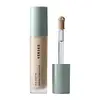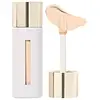Versed Skin Solution Serum Concealer Versus Westman Atelier Vital Skincare Brightening Concealer With Hyaluronic Acid
What's inside
What's inside
 Key Ingredients
Key Ingredients

 Benefits
Benefits

 Concerns
Concerns

 Ingredients Side-by-side
Ingredients Side-by-side

Water
Skin ConditioningEthylhexyl Olivate
Skin ConditioningC9-12 Alkane
SolventCaprylic/Capric Triglyceride
MaskingOctyldodecanol
EmollientC15-19 Alkane
SolventPolyglyceryl-3 Polyricinoleate
EmulsifyingGlycerin
HumectantPropanediol
SolventCoco-Caprylate/Caprate
EmollientTridecyl Trimellitate
EmollientSorbitan Isostearate
EmulsifyingTriheptanoin
Skin ConditioningSilica
AbrasiveMagnesium Sulfate
3-O-Ethyl Ascorbic Acid
Skin ConditioningLecithin
EmollientCaffeine
Skin ConditioningKojic Acid
AntioxidantHydrolyzed Sodium Hyaluronate
Skin ConditioningHydroxyacetophenone
AntioxidantSqualane
EmollientCaprylyl Glycol
EmollientTriethyl Citrate
MaskingPolyurethane-10
Isostearic Acid
CleansingPolyhydroxystearic Acid
EmulsifyingDisodium Stearoyl Glutamate
CleansingMica
Cosmetic ColorantAluminum Hydroxide
EmollientPropylene Carbonate
Solvent1,2-Hexanediol
Skin ConditioningStearalkonium Hectorite
Gel FormingDisteardimonium Hectorite
StabilisingQuaternium-90 Bentonite
Trisodium Ethylenediamine Disuccinate
CI 77891
Cosmetic ColorantCI 77491
Cosmetic ColorantCI 77492
Cosmetic ColorantCI 77499
Cosmetic ColorantWater, Ethylhexyl Olivate, C9-12 Alkane, Caprylic/Capric Triglyceride, Octyldodecanol, C15-19 Alkane, Polyglyceryl-3 Polyricinoleate, Glycerin, Propanediol, Coco-Caprylate/Caprate, Tridecyl Trimellitate, Sorbitan Isostearate, Triheptanoin, Silica, Magnesium Sulfate, 3-O-Ethyl Ascorbic Acid, Lecithin, Caffeine, Kojic Acid, Hydrolyzed Sodium Hyaluronate, Hydroxyacetophenone, Squalane, Caprylyl Glycol, Triethyl Citrate, Polyurethane-10, Isostearic Acid, Polyhydroxystearic Acid, Disodium Stearoyl Glutamate, Mica, Aluminum Hydroxide, Propylene Carbonate, 1,2-Hexanediol, Stearalkonium Hectorite, Disteardimonium Hectorite, Quaternium-90 Bentonite, Trisodium Ethylenediamine Disuccinate, CI 77891, CI 77491, CI 77492, CI 77499
Water
Skin ConditioningC9-12 Alkane
SolventOctyldodecyl Neopentanoate
EmollientGlycerin
HumectantDiisostearoyl Polyglyceryl-3 Dimer Dilinoleate
EmollientSodium Potassium Aluminum Silicate
Disteardimonium Hectorite
StabilisingCaprylic/Capric Triglyceride
MaskingTribehenin
EmollientHelianthus Annuus Seed Oil
EmollientGlycyrrhiza Glabra Root Extract
BleachingGentiana Lutea Root Extract
Skin ConditioningCoffea Arabica Seed Extract
MaskingPalmitoyl Pentapeptide-4
Skin ConditioningHydrolyzed Sodium Hyaluronate
Skin ConditioningCoco-Caprylate/Caprate
EmollientDisodium Stearoyl Glutamate
CleansingSodium Chloride
MaskingCaprylyl Glycol
EmollientPropylene Carbonate
SolventPotassium Sorbate
PreservativeSilica
AbrasivePropanediol
SolventAluminum Hydroxide
EmollientCitric Acid
BufferingCI 77891
Cosmetic ColorantWater, C9-12 Alkane, Octyldodecyl Neopentanoate, Glycerin, Diisostearoyl Polyglyceryl-3 Dimer Dilinoleate, Sodium Potassium Aluminum Silicate, Disteardimonium Hectorite, Caprylic/Capric Triglyceride, Tribehenin, Helianthus Annuus Seed Oil, Glycyrrhiza Glabra Root Extract, Gentiana Lutea Root Extract, Coffea Arabica Seed Extract, Palmitoyl Pentapeptide-4, Hydrolyzed Sodium Hyaluronate, Coco-Caprylate/Caprate, Disodium Stearoyl Glutamate, Sodium Chloride, Caprylyl Glycol, Propylene Carbonate, Potassium Sorbate, Silica, Propanediol, Aluminum Hydroxide, Citric Acid, CI 77891
 Reviews
Reviews

Ingredients Explained
These ingredients are found in both products.
Ingredients higher up in an ingredient list are typically present in a larger amount.
Aluminum Hydroxide is a form of aluminum. It can be naturally found in nature as the mineral gibbsite. In cosmetics, Aluminum Hydroxide is used as a colorant, pH adjuster, and absorbent.
As a colorant, Aluminum Hydroxide may add opacity, or reduce the transparency. Aluminum hydroxide is contains both basic and acidic properties.
According to manufacturers, this ingredient is an emollient and humectant. This means it helps hydrate the skin.
In medicine, this ingredient is used to help relieve heartburn and help heal ulcers.
There is currently no credible scientific evidence linking aluminum hydroxide in cosmetics to increased cancer risk.
Major health organizations allow the use of aluminum hydroxide in personal care products and have not flagged it as a carcinogenic risk at typical usage levels.
Learn more about Aluminum HydroxideC9-12 Alkane is synethically created using alkanes, or paraffins. It is added to products as a solvent. This means its main purpose is to help dissolve ingredients and create even texture.
This ingredient is an emollient, solvent, and texture enhancer. It is considered a skin-softener by helping the skin prevent moisture loss.
It helps thicken a product's formula and makes it easier to spread by dissolving clumping compounds.
Caprylic Triglyceride is made by combining glycerin with coconut oil, forming a clear liquid.
While there is an assumption Caprylic Triglyceride can clog pores due to it being derived from coconut oil, there is no research supporting this.
Learn more about Caprylic/Capric TriglycerideCaprylyl Glycol is a humectant and emollient, meaning it attracts and preserves moisture.
It is a common ingredient in many products, especially those designed to hydrate skin. The primary benefits are retaining moisture, skin softening, and promoting a healthy skin barrier.
Though Caprylyl Glycol is an alcohol derived from fatty acids, it is not the kind that can dry out skin.
This ingredient is also used as a preservative to extend the life of products. It has slight antimicrobial properties.
Learn more about Caprylyl GlycolCi 77891 is a white pigment from Titanium dioxide. It is naturally found in minerals such as rutile and ilmenite.
It's main function is to add a white color to cosmetics. It can also be mixed with other colors to create different shades.
Ci 77891 is commonly found in sunscreens due to its ability to block UV rays.
Learn more about CI 77891Coco-Caprylate/Caprate is created from fatty coconut alcohol, caprylic acid, and capric acid.
It is a lightweight emollient. Emollients create a thin barrier on the skin to trap moisture in. This helps keep your skin hydrated and soft.
Once applied, Coco-Caprylate/Caprate is absorbed quickly and leaves a silky feel.
Coco-Caprylate/Caprate may not be fungal acne safe.
Learn more about Coco-Caprylate/CaprateDSG is used as a surfactant.
Surfactants are cleansing ingredients that help remove oil, dirt, and other impurities from the skin. They work by reducing surface tension between water and oils/dirt to allow them to be easily rinsed away.
Disteardimonium Hectorite comes from the clay mineral named hectorite. It is used to add thickness to a product.
It can also help stabilize a product by helping to disperse other ingredients.
Hectorite is a rare, white clay mineral.
Learn more about Disteardimonium HectoriteGlycerin is already naturally found in your skin. It helps moisturize and protect your skin.
A study from 2016 found glycerin to be more effective as a humectant than AHAs and hyaluronic acid.
As a humectant, it helps the skin stay hydrated by pulling moisture to your skin. The low molecular weight of glycerin allows it to pull moisture into the deeper layers of your skin.
Hydrated skin improves your skin barrier; Your skin barrier helps protect against irritants and bacteria.
Glycerin has also been found to have antimicrobial and antiviral properties. Due to these properties, glycerin is often used in wound and burn treatments.
In cosmetics, glycerin is usually derived from plants such as soybean or palm. However, it can also be sourced from animals, such as tallow or animal fat.
This ingredient is organic, colorless, odorless, and non-toxic.
Glycerin is the name for this ingredient in American English. British English uses Glycerol/Glycerine.
Learn more about GlycerinThis ingredient is created by putting sodium hyaluronate through hydrolysis.
You might know this as 'mini' or 'ultra low-molecular weight' hyaluronic acid. The small molecule size means it is able to travel deeper in the skin.
According to studies, low molecular-weight hyaluronic acid can:
One study from 2011 found ultra-low weight HA to show pro-inflammatory properties. Another study from 2022 found it to downregulate UV-B induced inflammation.
Hydrolysis is a process of changing a molecule using water or enzymes.
This ingredient is water-soluble.
Learn more about Hydrolyzed Sodium HyaluronatePropanediol is an all-star ingredient. It softens, hydrates, and smooths the skin.
It’s often used to:
Propanediol is not likely to cause sensitivity and considered safe to use. It is derived from corn or petroleum with a clear color and no scent.
Learn more about PropanediolThis ingredient is a solvent. It helps dissolve active ingredients and alter the texture of products.
Propylene Carbonate is commonly used in makeup and with clay, such as montmorillonite or bentonite.
Studies show this ingredient to be safe for cosmetics. When it is undiluted, it can cause skin irritation. (It is always diluted in skincare and makeup). This ingredient is water-soluble.
Propylene Carbonate is created from propylene glycol and carbonic acid.
Learn more about Propylene CarbonateSilica, also known as silicon dioxide, is a naturally occurring mineral. It is used as a fine, spherical, and porous powder in cosmetics.
Though it has exfoliant properties, the function of silica varies depending on the product.
The unique structure of silica enhances the spreadability and adds smoothness, making it a great texture enhancer.
It is also used as an active carrier, emulsifier, and mattifier due to its ability to absorb excess oil.
In some products, tiny microneedles called spicules are made from silica or hydrolyzed sponge. When you rub them in, they lightly polish away dead skin layers and enhance the penetration of active ingredients.
Learn more about SilicaWater. It's the most common cosmetic ingredient of all. You'll usually see it at the top of ingredient lists, meaning that it makes up the largest part of the product.
So why is it so popular? Water most often acts as a solvent - this means that it helps dissolve other ingredients into the formulation.
You'll also recognize water as that liquid we all need to stay alive. If you see this, drink a glass of water. Stay hydrated!
Learn more about Water